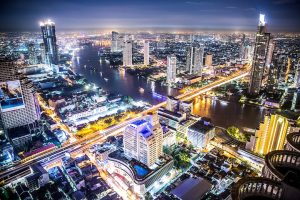Thailand, also known as the Land of Smiles, is a country with a rich historical heritage that dates back thousands of years. From ancient ruins and temples to museums and historical cities, Thailand offers a treasure trove of cultural and historical sites waiting to be explored. The country’s history is deeply intertwined with its unique culture, making it a fascinating destination for history buffs and cultural enthusiasts alike.
Thailand’s history can be traced back to prehistoric times, with evidence of human habitation dating back over 40,000 years. The region has been influenced by various civilizations and empires throughout its history, including the Khmer Empire, the Sukhothai Kingdom, the Ayutthaya Kingdom, and the Rattanakosin Kingdom. Each of these periods has left its mark on the country’s architecture, art, religion, and traditions.
Exploring the Lesser-Known Historical Sites in Thailand
While popular tourist destinations like Bangkok and Phuket offer a glimpse into Thailand’s history, there are also lesser-known historical sites that are worth exploring. These sites provide a more intimate and authentic experience, away from the crowds of tourists. Visiting these lesser-known sites allows travelers to delve deeper into Thailand’s rich historical heritage and gain a deeper understanding of its culture.
One such site is Phimai Historical Park in Nakhon Ratchasima province. This ancient Khmer temple complex dates back to the 11th century and is considered one of the most important Khmer ruins in Thailand. The park features intricately carved stone structures, including a large central sanctuary dedicated to Shiva. Exploring Phimai Historical Park offers a glimpse into the architectural prowess of the Khmer Empire and its influence on Thai culture.
Another lesser-known site is Phetchaburi Historical Park in Phetchaburi province. This park is home to several ancient temples and ruins, including Wat Mahathat Worawihan and Wat Kamphaeng Laeng. These temples showcase a blend of architectural styles, reflecting the influence of both the Khmer and Ayutthaya Kingdoms. The park also offers panoramic views of the surrounding countryside, making it a picturesque destination for history enthusiasts.
Discovering the Ancient Ruins of Sukhothai
One of the most significant historical sites in Thailand is the Sukhothai Historical Park. Located in the northern part of the country, Sukhothai was the capital of the Sukhothai Kingdom from the 13th to 15th centuries. The park is home to numerous ancient ruins and temples, which are a testament to the kingdom’s architectural and artistic achievements.
The highlights of Sukhothai Historical Park include Wat Mahathat, Wat Si Sawai, and Wat Sri Chum. Wat Mahathat is the largest and most important temple in the park, featuring a massive central stupa surrounded by smaller stupas and Buddha statues. Wat Si Sawai is known for its unique Khmer-style architecture, while Wat Sri Chum houses a giant seated Buddha statue that is one of the largest in Thailand.
Exploring Sukhothai Historical Park allows visitors to step back in time and imagine what life was like during the golden age of the Sukhothai Kingdom. The park’s serene atmosphere and well-preserved ruins make it a must-visit destination for history enthusiasts.
Unearthing the Mysteries of Ayutthaya’s Historical Parks
Another historical gem in Thailand is Ayutthaya, which was once the capital of the Ayutthaya Kingdom from the 14th to 18th centuries. Today, Ayutthaya is a UNESCO World Heritage site and home to several historical parks that showcase the kingdom’s glorious past.
The Ayutthaya Historical Park is the most famous of these parks and is home to numerous ancient ruins and temples. The park covers an area of over 289 hectares and features iconic sites such as Wat Mahathat, Wat Phra Si Sanphet, and Wat Chaiwatthanaram. Wat Mahathat is known for its iconic Buddha head entwined in the roots of a tree, while Wat Phra Si Sanphet was once the holiest temple in Ayutthaya and housed a 16-meter tall standing Buddha statue.
Exploring Ayutthaya’s historical parks offers a glimpse into the grandeur of the Ayutthaya Kingdom and its architectural achievements. The ruins and temples are a testament to the kingdom’s power and influence, and visiting these sites allows travelers to immerse themselves in Thailand’s rich history.
Tracing the Roots of Thai Culture at the National Museum Bangkok
For those interested in delving deeper into Thailand’s culture and history, a visit to the National Museum Bangkok is a must. Located in the capital city, the museum is the largest in Southeast Asia and houses an extensive collection of artifacts that span over 5,000 years of Thai history.
The National Museum Bangkok is divided into several galleries, each showcasing different aspects of Thai culture and history. The highlights include the Thai History Gallery, which provides an overview of Thailand’s history from prehistoric times to the present day, and the Buddhist Art Gallery, which houses a collection of Buddhist sculptures and artifacts.
Visiting the National Museum Bangkok allows travelers to gain a deeper understanding of Thailand’s cultural heritage and its influence on everyday life. The museum’s exhibits offer insights into Thai art, religion, architecture, and traditional customs, making it a fascinating destination for cultural enthusiasts.
Visiting the Hidden Temples of Chiang Mai

Chiang Mai, located in northern Thailand, is known for its rich cultural heritage and ancient temples. While popular temples like Wat Phra That Doi Suthep and Wat Chedi Luang attract a large number of tourists, there are also hidden temples in Chiang Mai that offer a more intimate and authentic experience.
One such temple is Wat Umong, also known as the “Tunnel Temple.” This unique temple is located in a forested area and features a series of tunnels adorned with Buddhist murals. The temple offers a peaceful and serene atmosphere, away from the hustle and bustle of the city.
Another hidden gem is Wat Suan Dok, which is known for its stunning sunset views. The temple houses several white chedis (stupas) that contain the ashes of Chiang Mai’s royal family. The peaceful grounds and beautiful architecture make it a popular spot for meditation and reflection.
Exploring the hidden temples of Chiang Mai allows travelers to experience the spiritual side of Thailand and gain a deeper understanding of its Buddhist traditions. The unique architecture and serene atmosphere of these temples make them a must-visit destination for those seeking a more authentic cultural experience.
Reliving the Glorious Past at the Grand Palace, Bangkok
No visit to Thailand would be complete without a visit to the Grand Palace in Bangkok. This iconic landmark is a symbol of Thailand’s grandeur and is one of the most visited tourist attractions in the country.
The Grand Palace was built in 1782 and served as the official residence of the Kings of Siam (now Thailand) for over 150 years. The palace complex covers an area of over 218,000 square meters and is home to several stunning buildings, including the Temple of the Emerald Buddha (Wat Phra Kaew).
The highlights of the Grand Palace include the Phra Thinang Chakri Maha Prasat, which is used for important royal ceremonies, and the Phra Mondop, which houses sacred Buddhist scriptures. The palace’s architecture is a blend of Thai, European, and Chinese styles, reflecting the influence of various cultures on Thailand’s history.
Visiting the Grand Palace allows travelers to step back in time and relive Thailand’s glorious past. The intricate details and opulent decorations of the palace are a testament to the country’s rich cultural heritage and its status as a kingdom.
Stepping Back in Time at the Historical City of Lopburi
Located in central Thailand, Lopburi is a historical city that dates back over 1,000 years. The city was once an important center of the Khmer Empire and later became a major city during the Ayutthaya Kingdom.
Lopburi is home to several ancient ruins and temples that showcase its rich history. The highlights include Phra Prang Sam Yot, also known as the Monkey Temple, which is overrun by monkeys that are considered sacred. The temple features three towering prangs (Khmer-style towers) and offers panoramic views of the city.
Another notable site is Wat Phra Sri Rattana Mahathat, which houses a famous Buddha image called Phra Kan. The temple’s architecture reflects a blend of Khmer and Ayutthaya styles, making it a unique destination for history enthusiasts.
Exploring the historical city of Lopburi allows travelers to step back in time and imagine what life was like during the Khmer and Ayutthaya periods. The ancient ruins and temples offer insights into the city’s past glory and its significance in Thailand’s history.
Uncovering the Secrets of the Golden Triangle’s Opium Trade
The Golden Triangle, located in northern Thailand, is infamous for its history of opium production and trade. During the 19th and 20th centuries, this region was one of the world’s largest opium-producing areas, with opium playing a significant role in the local economy.
Today, visitors can uncover the secrets of the Golden Triangle’s opium trade by visiting the Opium Museum in Chiang Rai. The museum provides a comprehensive overview of the history of opium production and its impact on the region. Exhibits include opium paraphernalia, historical photographs, and information about the social and economic consequences of the opium trade.
In addition to the museum, travelers can also visit the Hall of Opium, which is located nearby. This interactive museum offers a more immersive experience, with multimedia presentations and exhibits that explore the history, science, and social impact of opium.
Visiting the Golden Triangle’s opium-related sites allows travelers to gain a deeper understanding of Thailand’s history and its complex relationship with opium. It also serves as a reminder of the country’s efforts to combat drug trafficking and promote sustainable development in the region.
Rediscovering the Lost City of Wiang Kum Kam
Wiang Kum Kam is an ancient lost city located just outside of Chiang Mai. The city was founded in the 13th century by King Mangrai, who later moved his capital to Chiang Mai. Over time, Wiang Kum Kam was abandoned and eventually forgotten until its rediscovery in the 1980s.
Today, visitors can explore the ancient ruins and temples of Wiang Kum Kam, which offer a glimpse into the city’s past glory. The highlights include Wat Chedi Liam, which features a unique square-shaped chedi (stupa), and Wat Chang Kham, which houses a large Buddha statue.
Exploring Wiang Kum Kam allows travelers to step back in time and imagine what life was like during the reign of King Mangrai. The well-preserved ruins and temples provide insights into the city’s architecture, art, and religious practices.
Thailand’s rich historical heritage offers a fascinating glimpse into its past and its unique culture. From ancient ruins and temples to museums and historical cities, the country is a treasure trove of cultural and historical sites waiting to be explored. Visiting these sites allows travelers to gain a deeper understanding of Thailand’s history, architecture, art, and traditions.
Exploring lesser-known historical sites like Phimai Historical Park and Phetchaburi Historical Park offers a more intimate and authentic experience, away from the crowds of tourists. The ancient ruins and temples of Sukhothai and Ayutthaya provide insights into the grandeur of the Sukhothai and Ayutthaya Kingdoms, while the National Museum Bangkok offers a comprehensive overview of Thai culture and history.
Visiting the hidden temples of Chiang Mai allows travelers to experience the spiritual side of Thailand, while the Grand Palace in Bangkok offers a glimpse into the country’s royal past. The historical city of Lopburi showcases its significance during the Khmer and Ayutthaya periods, while the opium-related sites in the Golden Triangle shed light on Thailand’s complex relationship with opium.
Lastly, rediscovering the lost city of Wiang Kum Kam allows travelers to step back in time and imagine what life was like during the reign of King Mangrai. These sites are a testament to Thailand’s rich cultural heritage and its status as a kingdom with a glorious past. So, if you’re planning a trip to Thailand, make sure to explore these historical sites and learn more about the country’s culture and history.
If you’re fascinated by the rich history of Thailand and want to uncover its hidden gems, then you won’t want to miss this article on “Exploring Ancient Temples in Thailand” from ThaiTourism.net. This captivating piece takes you on a virtual journey through some of the country’s most awe-inspiring temples, revealing their architectural beauty and historical significance. From the iconic Wat Arun to the lesser-known Wat Rong Khun, this article provides a comprehensive guide to exploring Thailand’s ancient temples. So, grab your virtual passport and embark on a cultural adventure by clicking here.
FAQs
What is the article about?
The article is about uncovering lesser-known historical sites in Thailand that are worth visiting.
What are some of the historical gems mentioned in the article?
Some of the historical gems mentioned in the article include the ancient city of Wiang Kum Kam, the ruins of Sukhothai, the temple of Wat Phra That Lampang Luang, and the ancient city of Si Satchanalai.
Why are these historical sites important?
These historical sites are important because they offer a glimpse into Thailand’s rich cultural and historical heritage. They also provide an opportunity for visitors to learn more about the country’s past and appreciate its architectural and artistic achievements.
Are these historical sites easily accessible?
Most of these historical sites are easily accessible by public transportation or private car. However, some of them may require a bit of hiking or walking to reach.
Are there any admission fees for these historical sites?
Yes, there are admission fees for most of these historical sites. The fees vary depending on the site and may be higher for foreign visitors.
Are there any restrictions on visiting these historical sites?
Yes, there may be some restrictions on visiting these historical sites. For example, visitors may be required to dress modestly and remove their shoes before entering certain temples. Photography may also be restricted in some areas.




